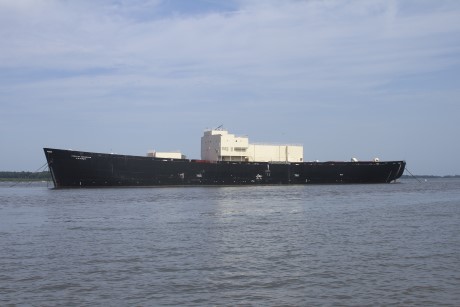CB&I to decommission floating reactor
14 April 2014
The USA's only floating nuclear power plant will be decommissioned by CB&I under a $34.7 million contract. The MH-1A reactor provided power to the Panama Canal zone before being shut down in 1976.
 |
| The Sturgis has been moored at James River, Virginia since 1978 (Image: P Bloodgood/US Army Corps of Engineers) |
The contract will see CB&I transport the vessel, the Sturgis, to Galveston, Texas in September. The company will then be responsible for decommissioning, dismantling and disposing of both the reactor and the vessel. After the removal of residual radioactive waste, the remaining portions of the Sturgis will be transported to Brownsville, Texas for disposal or recycling as scrap using standard shipbreaking methods. The entire process is expected to take less than four years to complete.
The MH-1A reactor was built by the US Army Corps of Engineers under the US Army Reactor Program of the 1950s and 1960s. The reactors were used to train military nuclear operators, provide power for military operations and to provide power for remote areas. Three such reactors were built. Two of them - SM-1 at Fort Belvoir in Virginia and SM-1A at Fort Greely in Alaska - were land-based, while MH-1A was installed on the Sturgis, a former World War II Liberty ship. SM-1 and SM-1A were deactivated in the early 1970s.
MH-1A entered operation at Fort Belvoir in 1967, and the Sturgis was towed to Gatun Lake in the Panama Canal Zone in 1968. The 45 MWt pressurized water reactor had a net capacity of 10 MWe and generated electricity for both military and civilian use, but by 1976 the availability of land-based generating capacity in the area meant the reactor was no longer needed and the ship was towed back to the USA.
MH-1A was formally deactivated in 1978, when its nuclear fuel was removed and returned to the US Department of Energy. After the removal of most of the nuclear materials and radioactive waste from the ship and decontamination work, remaining radioactive materials were sealed for safe long-term storage and the Sturgis was towed to the James River Reserve Fleet in Virginia, where it has remained. It is now the responsibility of the US Army Corps of Engineers, Baltimore District.
Originally, plans envisaged holding the Sturgis in a safestore situation until 2027, before beginning final decommissioning and disposal work. However, this is no longer seen as the optimum, or the most cost-effective, path.
Although the USA's only floating reactor left service nearly four decades ago, the concept of floating nuclear reactors has not passed into history. Russia is currently building its first floating nuclear power plant, the Akademik Lomonosov, which will host two 35 MWe reactors and is currently scheduled to enter service in late 2016.
Researched and written
by World Nuclear News